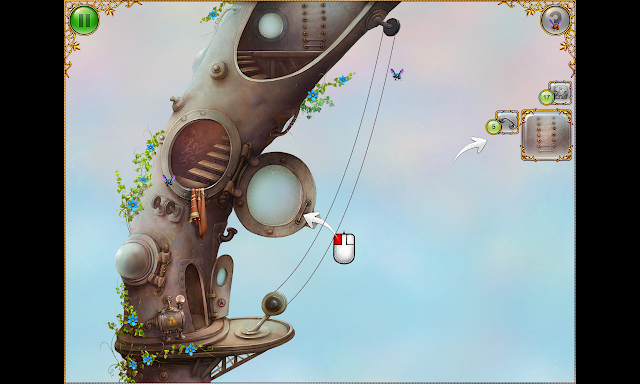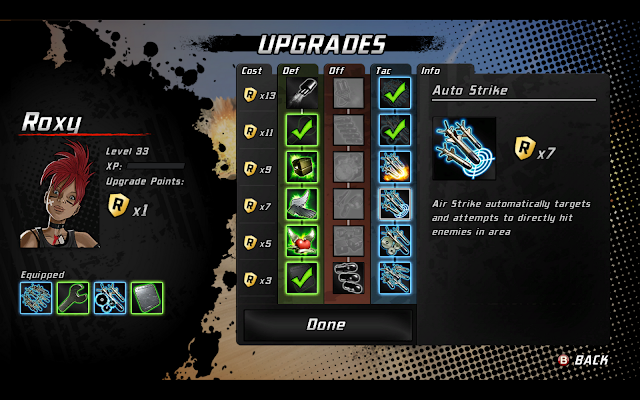Bastion is an Action/RPG/Indie game that is pretty unique in
my gaming history, and one which I think you'll most likely enjoy. Here's why:
You take on the role of the kid, who wakes up after the
world has literally fallen to pieces in an event known as the Calamity.
Fighting your way through wind bags, defense turrets, and plenty of other
enemies, you eventually make it to the Bastion, the place where all of your
people are supposed to gather in an event like this - except there is only one
other person there. Luckily, this Stranger happens to know the Bastion's
purpose, and that if you hunt down crystals, found out in the scattered
remnants of the world, you can put everything back like it was.
And so you journey forth, into a world driven mad by the Calamity,
in search of the means by which to put things right.
 |
When they say the world in Bastion has fallen apart, they
mean that literally.
|
Before jumping into the combat of Bastion, I need to cover
the level design, particularly how the levels appear on screen. You see, you're
fighting your way across the slivers of world that still exist - tiny expanses
of what where once the wilds or the lands of your people. So generally there
isn't much room at any one time. This is further emphasized by the way the
level falls into place as you explore it, meaning that at many times you're not
actually sure what the boundaries of the level are, until you head in that
direction. The result is a sense of dynamic exploration, and indeed you can
find hidden pathways or items if you're
will to spending time testing the limits of each level, which includes
destroying rubble or other items that might be blocking those pathways.
How does that all fit into combat you ask? Well, it's quite
simple, because enemies work the same way. They may not pop up on screen, or
drop down onto the level as it were, until you get close enough. More
importantly, the level design matters when you are fighting several enemies in
the same area, usually in a series of waves, because some of them are large
enough to actually destroy parts of the level. All these things factor into how
you'll proceed with fighting your enemies, because while falling isn't
automatically fatal, the amount of health lost can make all the difference.
 |
| Making close quarters even closer. |
When you are actually fighting, rather than just dodging the
dangers of the level itself, you'll find that there are plenty of choices in
how you approach the situation. At first you start with the Cael Hammer, Fang
Repeater, and Breaker's Bow, though you are limited to only two weapons at any
one time. Soon the choice gets harder, because there are plenty of other
weapons in the game too. If you want to use a firearm, you can stick with the
repeater, switch to the Dueling Pistols, or try the Scrap Musket. If melee is
more of your thing, beyond the hammer, you could use the War Machete or Brusher's
Pike. For something a little more exotic, there is the Calamity Canon, which is
a rocket launcher, or the Galleon Mortar. Beyond just weapons, you've got your
trusty Bullhead Shield, which can be used to avoid attacks, or, if you can time
it properly, trigger a counter attack. Or, because you don't have enough
options yet, you can always do a dodge/roll, which not only gets you out of
harm's way, but it can also be used as an attack in and of itself.
Of course, we're far from done. You see, there are several
structures available back in the Bastion, and at the end of each level you get
the chance to unlock or upgrade one more, depending on what portion of the game
you're in. There are a total of six buildings, two of which focus on your
weapons, with those being the forge and arsenal. At the arsenal you can change
which weapons you have equipped, as well as what your special ability is - an
action which grants some kind of special effect such as launching a grenade to
deal massive damage, but which in many cases requires a certain weapon to be
equipped to actually use. Furthermore, you cannot use your special ability
unless you have a black tonic, which you collect periodically throughout the
levels.
The forge lets you upgrade a weapon, which requires a
special item you'll either find out in the wild or buy in the store, as well as
a sizable chunk of this game's currency. The rewards for it are well worth the
cost though, as there are, eventually, five upgrade levels for each weapon,
where at each level you are faced with a choice about what you would like your
weapon to do, such as picking between faster reload or more damage, though you
can alter your choice any time you return to the forge. So when you start
customizing your weapons, you can come up with some interesting play styles.
Personally, I'm a fan of the Brusher's Pike and the Galleon Mortar, because
I've upgraded the Pike to ignore armor, and in addition to using it as a melee
weapon, I can charge it up and throw it for those pesky flying enemies out in
space. For everything else, well, there isn't much a well timed shot from the
mortar can't handle, particularly since one of it's special abilities launches
in a friendly turret to fight for you, just in case things ever get a bit
sketchy.
 |
| For when a regular mortar isn't enough, just add Inferno Propellant. |
The next building you should know about is the distillery,
which allows the use of tonics. You'll buy these out of the store, one of the
other buildings in the Bastion, and they grant special abilities or
augmentations to your character. Each time you level up, because Bastion
incorporates the familiar XP mechanic that is pretty much standard to all RPGs,
you'll unlock a slot for another tonic. Some do slightly useful things like
absorbing stray fragments, the game currency, which saves you the time involved
in running around and otherwise collecting them manually. More useful ones make
you retaliate whenever you take damage, or offer a chance to become enraged and
do significantly more damage whenever you defeat a foe. Still others provide a
benefit, but also maintain a cost, such as allowing you to leech some health
out of enemies, but making your health tonics far less potent.
Of the last two buildings in the Bastion, which would be the
memorial and the shrine, the shrine is by far the more interesting one. Sure,
the memorial is nice as it contains in game achievements that reward you with
lots of fragments if you complete them, but the shrine can make the game much
harder, and the rewards much greater, if you choose to be so brave. You see,
the shrine contains idols to the gods, 10 in all, and these idols, when they
are activated, change the game. One increases your enemies' resistance to
damage, while another makes them retaliate on death via a grenade. Still
another makes them stronger, while another allows them to regenerate health.
And these aren't even the worst of them, just to give you an idea of how they
impact gameplay. The reason why you might want to give this a try is because
for each idol you activate you gain an increase to the amount of fragments and
experience you'll gain. When you add that in with the ability to customize your
weapons through the forge and arsenal, and change your character at the
distillery, you'll realize there are plenty of options that can drastically
change the way you play through this game.
 |
| The question you'll have to ask yourself is, is the
reward worth the risk? |
I do realize after all that talk of story, level design,
customization of the weapon, character, and difficulty varieties, I have yet to
actually talk about the enemies you'll face. Bastion does maintain an interesting
mix of baddies, from the different types of wind bags and defense turrets
you'll face early on, to the wild peckers and anklegators during the middle of
the game, to the deadly Ura fighters later on, there are plenty of things out
there looking to kill you. Some enemies simply try and smash you, including the
very large wind bags that are capable of destroying parts of the world. Other
enemies stick with ranged attacks, such as certain peckers, which are birds, or
Ura armed with rifles. Then there are plenty of plants which fire out mortar
like objects or just seem content to fill you full of spines or bathe an area
is poison gas, and some of which are heavily armored until they open up and
expose their weak inner core, which would be the reason I use the Brusher's
Pike with it's armor ignore upgrade. You'll have to come up with some strategy
for dealing with the multitude of enemies in this game, taking the time to
understand the weak points and what are the best methods for exploiting them.
Just try not to die too much as you're dodging giant scum bags or charging
lunkheads.
The final thing I'd like to touch on is probably what
Bastion is best known for - the narration. Not only does Logan Cunningham pull
of a voice that should put Morgan Freeman out of work, but much of the
narration is dynamic. Run through the first level without taking time to
explore, and the narrator comments that you don't even slow down. Start
destroying things, and he might say that all of a sudden you're raging.
Discover some of the people the calamity has turned to stone/ash, then destroy
them, and he'll make a comment about how that guy always wanted his ashes
scattered. Further more, and I know this from trying to capture certain lines
for a potential video review, just because you do things the same way twice
doesn't mean you'll get the same result. Even starting a level over and over
again, outside of the several survival mode experiences, and you may not get
the same intro for quite a while. It all goes to give Bastion a feeling of
depth and humanity that goes far beyond almost anything another game has done,
and I for one approve.
 |
| Until I find a way to take a picture of a voice,
this image of Rucks will just have to do. |
Bastion is one of those rare gems in gaming that really
stands out. It does have a lot going for it, from the art, to the solidness of
the gameplay, to the story, to the extent to which you can customize your
experience, and of course, the narration. I put just over 10 hours into the
game, unlocking almost all the weapon's upgrades and doing all the extra
challenges. There is a New Game + option once you beat it the first time
through, and it's there that you'll uncover some bonus content that was added
after release, such as the Stranger's Dream, a new survival experience that
gives you some of the backstory on Rucks and the world Bastion is set in. While
it has been on sale for less, I advocate for paying no less than $10, and would
try and encourage you to go for the full price at $15. Bastion is just one of
those games that is an excellent experience, and worth every penny - 10 out of
10.
So, the final breakdown:
Score: 10/10
Suggested Price: $10+































